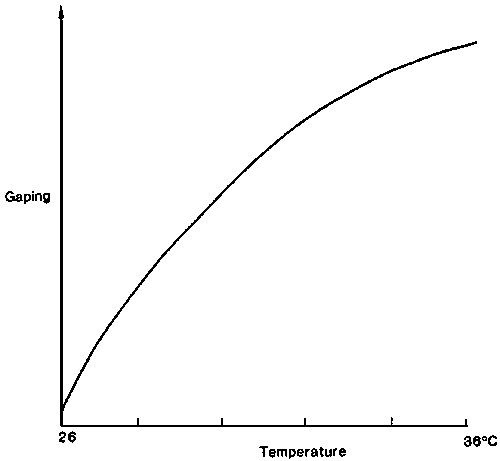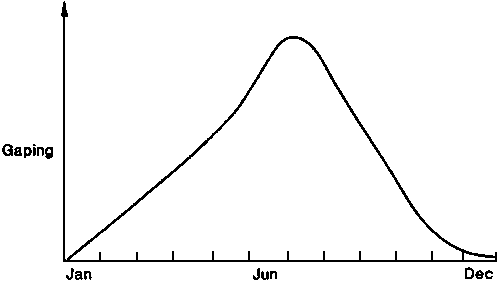Introduction
What is gaping?
How is the fillet held together?
Causes of gaping
How to reduce gaping
This note defines gaping, explains the principal causes of it, and indicates how care during handling and processing of salmon and trout can reduce many of the adverse effects. The note amplifies the more general advice on gaping given in Advisory Note 61.
The cut surfaces of a fish fillet shows that the flesh consists of small blocks of muscle, for the most part rectangular in shape, bordered by thin shiny membranes of connective tissue. When a fillet is cooked, the connective tissue breaks down and the blocks of muscle separate easily and fall apart; this is in effect an extreme form of gaping. The term gaping in the context of this note, however, is reserved for the undesirable separation of muscle blocks in a raw fillet.
Gapes are slits between muscle blocks, and can range from slight separation at the cut surface to complete separation right down to the skin of a fillet. Gaping spoils the appearance of fillets, making them difficult to sell, and makes skinning difficult or impossible. Sides of smoked salmon that gape arc sometimes impossible to cut into thin slices. Gaping is not a problem in trout that arc sold whole, but an increasing proportion of larger trout is now sold as fillets, so that gaping can be a problem for this species also.
A block of muscle consists of thousands of parallel threadlike muscle cells, each about the thickness of a human hair. Each cell is encased in a tiny tube of connective tissue that meets and merges with a flat sheet of connective tissue, roughly at right angles at each end of the cell. The tubes are probably of the same material as the sheets and an extension of them. It is because the tubes merge at both ends with a sheet of connective tissue that the enclosed muscle cells are so firmly attached. When the junctions between tubes and sheets break, gaping occurs.
Handling
Rough handling of whole fish can cause physical damage that may lead to subsequent gaping of the fillets, but valuable farmed fish are rarely thrown about or stood upon. A more likely cause is the handling of fish that have become stiff in rigor and have taken up a bent position; when such fish are forcibly straightened, perhaps in order to pack them or to feed them into a machine, they are damaged internally, and the resultant fillets may gape severely.
High temperature rigor
Muscular contraction in a whole fish during rigor can be a cause of gaping. The contraction becomes stronger and the connective tissue weaker as fish temperature rises, eventually resulting in gaping when the fish is filleted. Fillets from cod for example will begin to gape when the whole fish has gone into rigor at 17°C, and cod held at 20°C throughout the period following death will yield fillets that gape severely. The critical temperature for trout is higher; whole fish held below 26°C are unlikely to yield gaping fillets but, at 30°C or above, gaping can be severe. Small fish warm quickly, however, and newly harvested trout lying beside a rearing pond, for example, can quickly reach the critical temperature on a hot day.
EFFECT OF TEMPERATURE ON GAPING OF TROUT

Freezing
Fillets from thawed whole fish are more likely to gape than fillets from unfrozen whole fish but, when whole fish are frozen before rigor sets in, subsequent gaping is much reduced or absent.
A fillet cut from a fish before the onset of rigor feels sticky and rubbery, but a fillet cut from a fish in rigor feels wet because there is more free fluid present in the muscle. When a whole fish is frozen after the onset of rigor, this free fluid forms as ice at the junctions between the tubes and sheets of connective tissue, and prises the tubes away. This action, aided probably by the tension of the muscle in rigor, causes gaping.
Since farmed salmon often do not enter rigor until 18 hours after death, there is usually enough time to freeze them before rigor begins. Freezing should be done quickly enough to be completed before the onset of rigor.
Farmed salmon are sometimes stunned with carbon dioxide prior to bleeding; this technique speeds the onset of rigor by several hours, and markedly reduces the time available for prerigor freezing.
Smoking
A high temperature alone can cause gaping, independently of any enhanced rigor effect. This effect has been observed when sides of salmon are smoked at too high a temperature early in the process, for example on a hot day in a traditional kiln without temperature control. A rise in temperature later in the smoking process is less damaging because by then the salmon sides have lost some water, and a protective glossy pellicle has formed on the cut surface; ample water has to be present before the connective tissue breaks down.
Seasonal variation
Farmed salmon gape more when harvested in summer than in winter, because the chemical composition of the muscle changes after the fish resume feeding actively in the spring. The period of maximum gaping is linked to the date of resumption of feeding after the winter cold, and so can vary from year to year, but the peak is typically between June and August, as the graph shows.
SEASONAL VARIATION OF GAPING IN SALMON

Handle the fish carefully at all times, and never change the shape of a fish that is stiff in rigor.
Chill the fish as soon as possible after harvesting. If any have inadvertently warmed, chill them in ice before handling them further.
If the fish are to be frozen, freeze them as soon as possible after death, freeze quickly, and complete the process before rigor begins. To aid rapid freezing, the fish should preferably be frozen singly. If the fish have to be frozen in boxes, use shallow boxes and leave the lids off during freezing, so that freezing is completed before onset of rigor.
Thawing of frozen fish should be done at the lowest practicable temperature, and never above 20°C.
Treat fish harvested in summer with extra care; some gaping is probably unavoidable, but careful handling, and chilling immediately after harvesting, can keep this to a minimum. Avoid freezing summer fish if this is possible.
When smoking sides of salmon, do not allow the temperature of the kiln to rise too high during the early part of the process.
If you have any enquiries, write, phone, or call at the address below:
The Director,Other recent Notes in this series, which are available free of charge in the UK from the above address are:
Torry Research Station,
PO Box 31,
13 5 Abbey Road
Aberdeen AB9 8DG
Tel. 0224877071
61 Gaping of fillets, by R.M. LOVE.62 The freezing time of fish, by F.J. NICHOLSON.
63 Fishing ports in the UK, by J.J. WATERMAN.
64 Fish silage, by I. TATTERSON and M.L. WINDSOR.
65 Fishworking machinery, by S. MAIR.
66 Handling and processing mackerel, by J.N. KEAY.
67 The haddock, by J.J. WATERMAN.
68 Icemaking plant, by J. GRAHAM.
69 Cook-freeze fish products, by J.N. KEAY.
70 Advice for the fish industry; who does what, by J.J. WATERMAN.
71 Processing cod; the influence of season and fishing ground, by R.M. LOVE.
72 Reducing odour in fish meal production.
73 Stowage of fish in chilled sea warter, by J.H. KELMAN.
74 Handling and processing rainbow trout, by A. MILLS.
75 Freezing small pelagic fish, by I. MCDONALD.
76 Dark colour in white fish flesh, by R.M. LOVE.
77 Squid, by G.D. STROUD.
78 Health hazards of handling industrial fish, by A. WARD.
79 Minced fish, by J.N. KEAY.
80 Round worms in fish, by R. WOOTTEN and D.C. CANN.
81 Handling and processing blue whiting.
82 Hot smoking of fish, by A. McK. BANNERMAN.
83 Fish smoking; if dictionary, by J.J. WATERMAN.
84 Handling and processing oysters, by G.D. STROUD.
85 Chilled and frozen fish: a dictionary, by J.J. WATERMAN.
86 Shopping for fish: advice on quality, by A. CRAIG.
87 Composition and quality of fish: a dictionary, by J.J. WATERMAN.
88 Packing fish in a modified atmosphere, by D.C. CANN.
89 Measuring fish composition, by A. AITKEN, A. LEES and J.G.M. SMITH.
Earlier notes in the series, most of which are still available, are summarized in:60 Key to Advisory Notes 1 -59, by J.J. WATERMAN.
Crown Copyright Reserved
Printed in England for H.M.S.O. Dd8835619. 1123